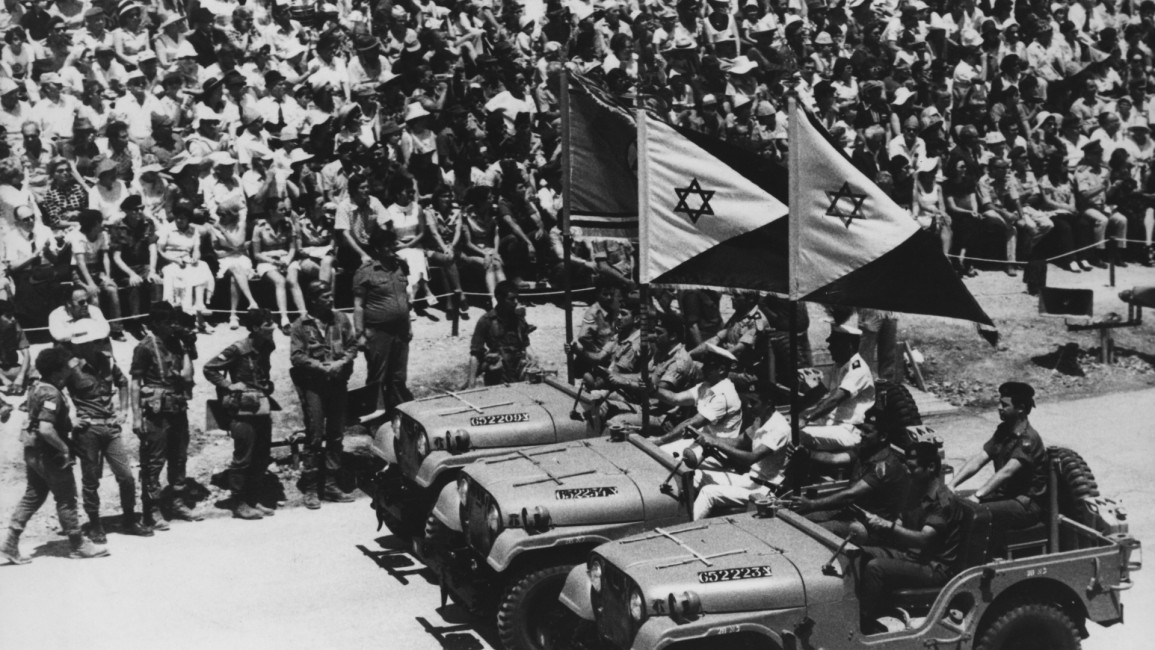
The Six-Day War laid the foundations for the Israel Lobby
Fifty-five years ago on the morning of 5 June, almost the entire Israeli air combat force, roared into the sky on a mission that would change the face of the Middle East.
Flying low with complete silence, the Israeli jets pounded the Egyptian aircrafts as they perched on the ground, destroying or paralysing most of the Egyptian Airforce, before the IAF turned its attention to Syrian and Jordanian airstrips later that day.
What followed was a multi-front land invasion, swallowing the rest of historical Palestine (the Gaza Strip and West Bank, including East Jerusalem), and occupying the Egyptian Sinai Peninsula and the Syrian Golan Heights.
In only six days, Israel increased its landmass threefold, and with that came what became known as the 1967 occupation, the Naksa (setback) for Arabs.
''Secure in its impunity and the US unconditional backing, Israel brushed off the UN resolutions to withdraw from the Palestinian territories and ignored the various peace initiatives to incentivise it in that direction. The occupation only evolved and deepened.''
To this day, the debate continues about whether Israel’s pre-emptive strike was justified on an existential basis, or was simply an aggressive war of choice.
The accepted orthodoxy among Israel’s mainstream and their supporters is that the war and the occupation that followed were justified because Egypt, Jordan, and Syria had massed troops “vastly outnumbering Israel” along the border. Threatened with its very survival, Israel launched a necessary pre-emptive strike on its neighbours.
Israeli-Jews like to depict the weeks leading up to the war as the ominous “waiting period” when a second Shoah was imminent. In The Seventh Million, Israeli historian Tom Segev explains that the Shoah reverberations were very widespread then that rabbis were seen sanctifying mass graves in public parks in the anticipation of an Egyptian attack.
It is this Shoah narrative, more than anything else, that boosted Israel’s victim status in the West and substantiated its story about the war. That triggered an unprecedented wave of solidarity, especially among American Jews, who before 1967 did not passionately identify with Israel or Zionism, and neither was the Shoah to them a central part of their Jewish identity.
The crisis, in effect, injected an emotional reality that helped generate the power of the Israel Lobby in the US. It was the primary base that augmented Israel’s geopolitical and geo-strategic posture today, and accumulatively led to its current impunity and absence of accountability.
That said, emerging evidence now suggests that in the mid-1960s, the Arab quantitative advantage was undermined by Israel’s qualitative superiority. The Israeli Western-made offensive weapons, like Mirage fighters and ground attack-aircrafts, were not vulnerable to an eventual Arab attack, and Israeli airspace was impenetrable for the mostly Soviet-made Arab aircrafts. In contrast, by December 1966, Israeli jet-fighters routinely penetrated Egyptian airspace up to the Suez Canal and had even flown over Cairo on occasions.
What is more, the Mossad - assisted by the CIA and MI6 - knew that the Arab states were not militarily on par with Israel and that their anti-Israel rhetoric was just a bluster.
A 2004 CIA report stated that Israel exaggerated the Arab threat to acquire more aid, and that the Israeli leaders knew that Israel would easily win, whether it landed an offensive or absorbed an Egyptian first strike. This was confirmed in a 2017 Israeli Channel 10 report, which revealed that between 1956 and 1967 Israeli pilots trained intensively on low-altitude and silent flying to attack Egypt.
The war was one of choice, and what Israel did was seize the opportunity to break Egypt’s Nasser and expand its territory, for geopolitical and ideological purposes. There was a belief among Israel’s statesmen, as Azmi Bishara explains, that the 1948 colonial takeover of Palestine was incomplete, and that the Arabs were never going to stop opposing it. Reshuffling the territorial priorities would create new facts on the ground that can be used - and have - as a bargaining chip against the Arab states.
Egypt, through military means and negotiations, eventually retrieved the Sinai Peninsula and signed a (cold) peace with Israel in 1979. The Syrian Golan Heights were unilaterally annexed in 1981.
It is the Palestinians who dealt with the brunt of the war, and continue to do so today. Almost overnight, by occupying the Gaza Strip and West Bank - the remainder of historical Palestine - Palestinian refugees in those areas became “refugees under occupation” by the same regime that drove them out of their homes 19 years prior. This happened at a time when decolonisation movements were spreading around the world.
Instead of becoming flexible after a victory that alleviated its “existential fears” - or at least it was the claim - Israel’s position has since grown ever more intransigent toward peace, and most certainly, against the Palestinians.
Secure in its impunity and the US unconditional backing, Israel brushed off the UN resolutions to withdraw from the Palestinian territories and ignored the various peace initiatives to incentivise it in that direction. The occupation only evolved and deepened.
What we have today is an unprecedented system of comprehensive military occupation embedded in a broader settler-colonial dimension, and which has eventually morphed into an apartheid system. The “three-tier matrix of oppression” (settler-colonialism, occupation, and apartheid) far exceeds the normalisation of the daily violations of Palestinian human rights, to depriving the Palestinian collective of even a political outlet to break free in the future.
The 1994 Oslo treaty, which was supposed to provide such an outlet, is today nothing but a relic of an ill-thought asymmetrical and rather bizarre agreement between occupier and occupied. And, whilst the Palestinian leadership is still desperately clinging to a two-state solution that is no longer viable, the Palestinian public certainly isn’t.
Many are convinced that Oslo was, in fact, a meticulous ruse to split the Palestine cause into two distinct spheres of operation: 1948 and 1967. With that, Palestinian justice was divided and weakened.
Yet, all signs now point to the emergence of new methods of resistance, and with them a reconceptualisation of the nature of Israel’s occupation. For the new Palestinian generations, especially those born into the impasse of the so-called peace process, it is no longer about the 1967 occupation only, but also about Israel’s “original sin,” the 1948 Nakba, and Palestinian historical rights and transitional justice.
After all, justice is indivisible. The 1948 dispossession and 1967 occupation are not separate events, but two phases of the same project. Both are injustice and resolving one will remain incomplete without the other.
Dr Emad Moussa is a researcher and writer who specialises in the politics and political psychology of Palestine/Israel.
Follow him on Twitter: @emadmoussa
Have questions or comments? Email us at: editorial-english@alaraby.co.uk
Opinions expressed in this article remain those of the author and do not necessarily represent those of The New Arab, its editorial board or staff.



